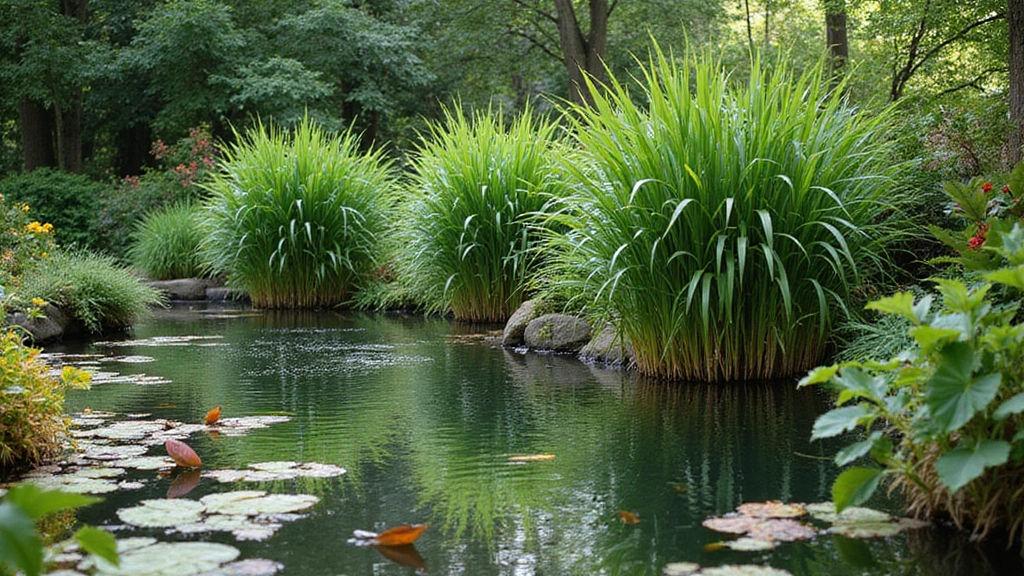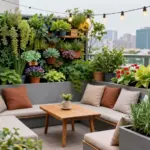Water gardens can transform your outdoor space into a serene oasis, and one of the best plants to include in this aquatic dream is the cat tails plant. Known for their tall, graceful appearance and unique brown flower spikes, cat tails (Typha) are not only visually striking but also beneficial to your pond’s ecosystem.
From their ability to filter water and provide habitat for wildlife to their stunning visual appeal, cat tails are a perfect choice for any water garden enthusiast. In this collection, we’ll explore innovative ideas to incorporate cat tails into your water garden and pond landscaping, ensuring that you create a tranquil retreat that showcases the beauty of nature. Discover how to blend these remarkable plants with other aquatic life, making your water feature a captivating focal point.
Get ready to transform your garden into a wildlife haven with these 30 fabulous cat tails plant ideas!
1. Emphasize Vertical Growth in Pond Edges
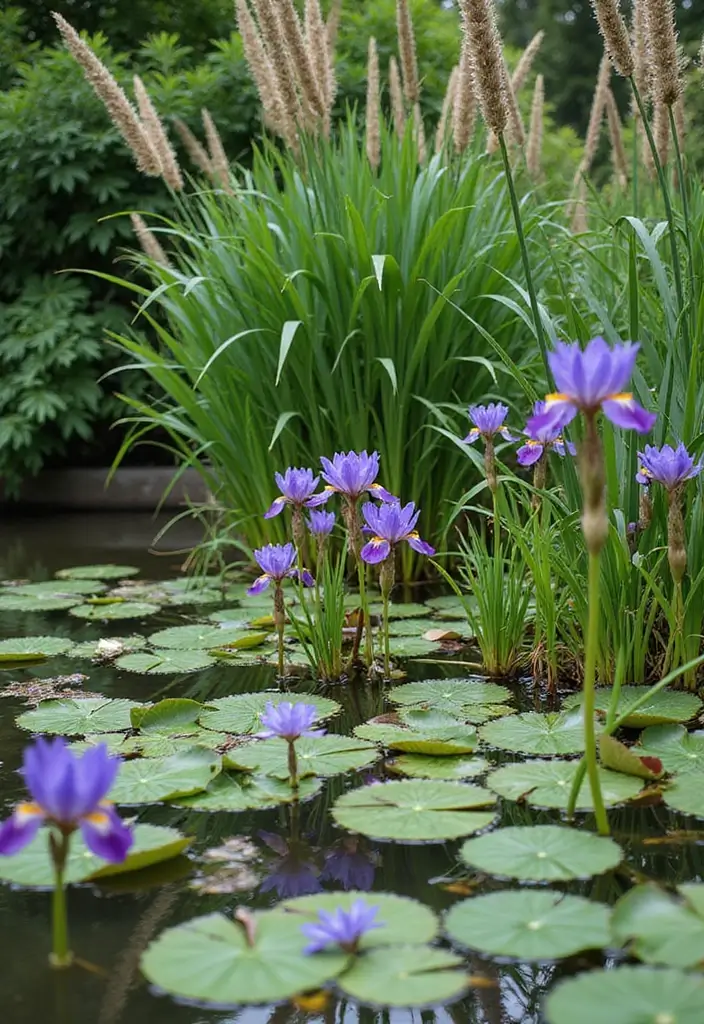
Cat tails naturally grow tall, making them an ideal choice for adding vertical interest to the edges of your pond. Planting them along the waterline not only enhances the visual appeal but also helps stabilize the soil, preventing erosion. With their height, they create a beautiful backdrop, allowing smaller aquatic plants to thrive in front.
When planning your layout, consider mixing different heights of plants for a layered look. Pair the cat tails with shorter flowers like water lilies and irises for a stunning contrast. Moreover, they provide a natural habitat for frogs and other wildlife, contributing to a balanced ecosystem.
Be mindful of spacing—cat tails can spread both through seeds and underground rhizomes. Maintain some distance between them and other plants to avoid overcrowding. Regularly inspect your garden for any invasive behavior to keep your pond healthy. In doing so, you not only create a beautiful water feature but also a functional habitat that supports local wildlife.
– Use cat tails on the outer edges of the pond for stability.
– Consider planting in clusters for dramatic effect.
– Regular care ensures they don’t overtake other plants.
2. Create a Natural Privacy Screen
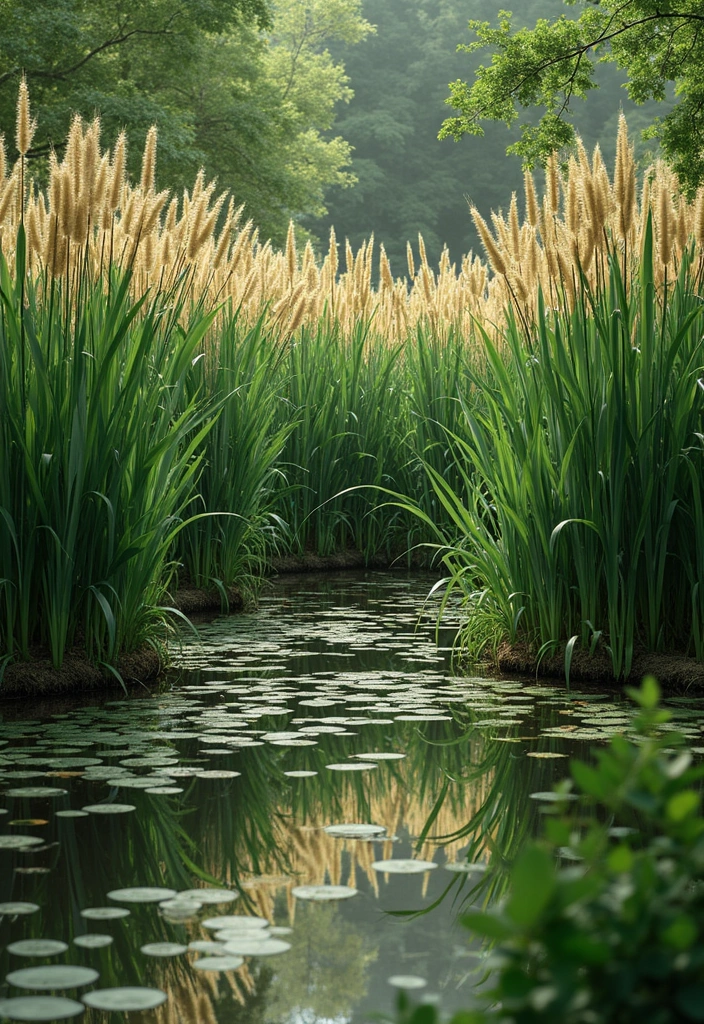
Cat tails can serve as an excellent living privacy screen around your pond, providing seclusion and a sense of tranquility. Their height and dense foliage act as a natural barrier, helping to shield your water garden from wind and prying eyes.
Position them strategically to frame your pond, creating an inviting area for relaxation and reflection. They can also help reduce noise, making your garden a peaceful retreat. If you’re concerned about visibility from neighbors or busy streets, planting a thick row of cat tails will do wonders to create that sanctuary feel.
For a lush look, consider mixing cat tails with other tall plants like reeds or ornamental grasses. This combination not only enhances the privacy factor but also adds texture and color to your garden. Just ensure that your plants are suited for the local climate and existing pond conditions for the best results.
– Plant them in groups for maximum density.
– Pair with other tall plants for added privacy.
– Regular trimming can help maintain their shape and height.
3. Combine with Colorful Water Lilies
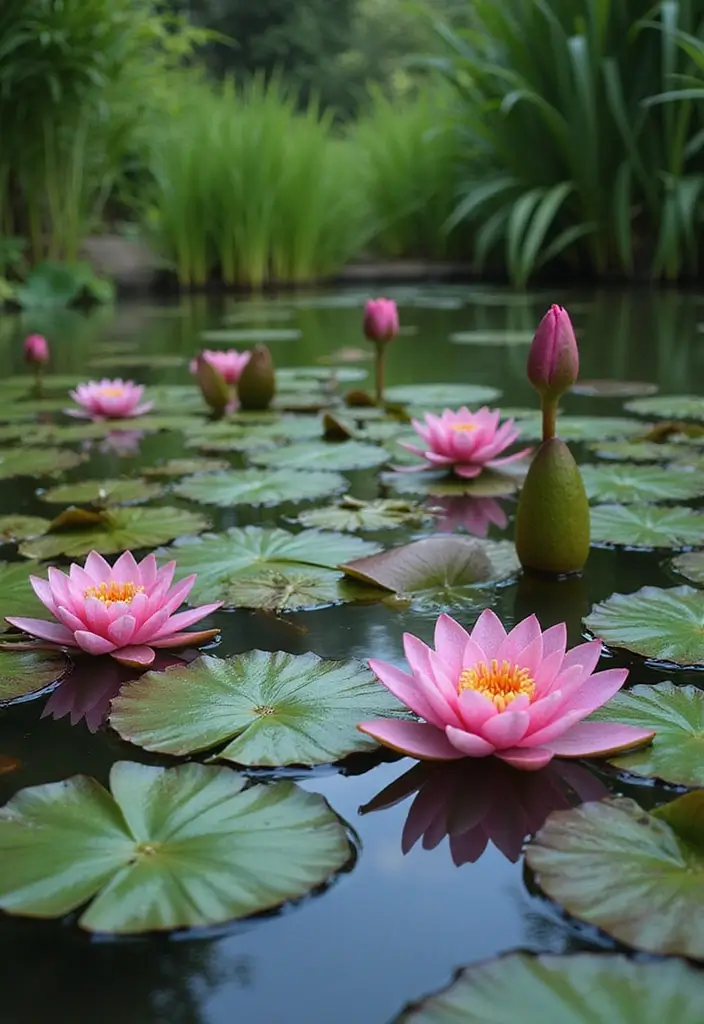
The lush green of cat tails can be beautifully complemented by the vibrant blooms of water lilies. This pairing not only creates a visually appealing contrast but also enhances the habitat for various aquatic species.
Water lilies float gracefully on the pond’s surface, while cat tails rise majestically above, creating a dynamic visual. Consider planting cat tails in clusters near the water’s edge and scattering water lilies throughout the pond for a harmonious look. This combination invites butterflies and bees, contributing to your garden’s overall biodiversity.
For the best results, choose water lily varieties that match your pond’s depth and sunlight exposure. Regularly check both plants for any signs of disease or overgrowth to maintain a balanced ecosystem. This approach ensures that both your cat tails and water lilies thrive together.
– Choose contrasting colors of water lilies to complement cat tails.
– Position water lilies deeper than cat tails to maintain balance.
– Monitor water quality and nutrient levels for optimal growth.
4. Use for Natural Filtration
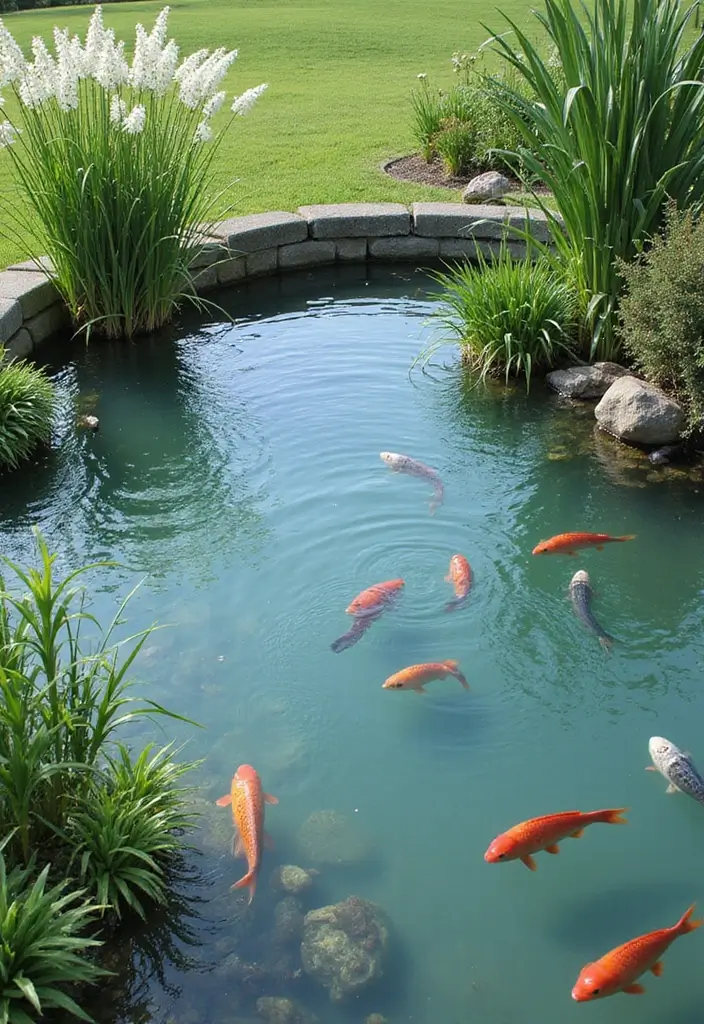
One of the most significant benefits of incorporating cat tails in your water garden is their natural water filtration abilities. The roots of cat tails help absorb excess nutrients and pollutants, leading to cleaner, healthier water.
As you design your pond, consider creating designated areas filled with cat tails where water can flow through. This setup not only improves water quality but also provides an ideal habitat for fish and other aquatic life. You’ll notice fewer algae blooms and clearer water, making your pond more enjoyable to watch.
Regular maintenance is key. Trim dead leaves and manage the density of the cat tails to ensure they don’t overcrowd other plants. By doing this, you promote a balanced ecosystem in your garden pond, leading to a thriving aquatic community.
– Plant cat tails in areas with moving water for better filtration.
– Regularly maintain plant density to prevent overcrowding.
– Monitor water quality to assess the effectiveness of filtration.
5. Foster Wildlife Habitats
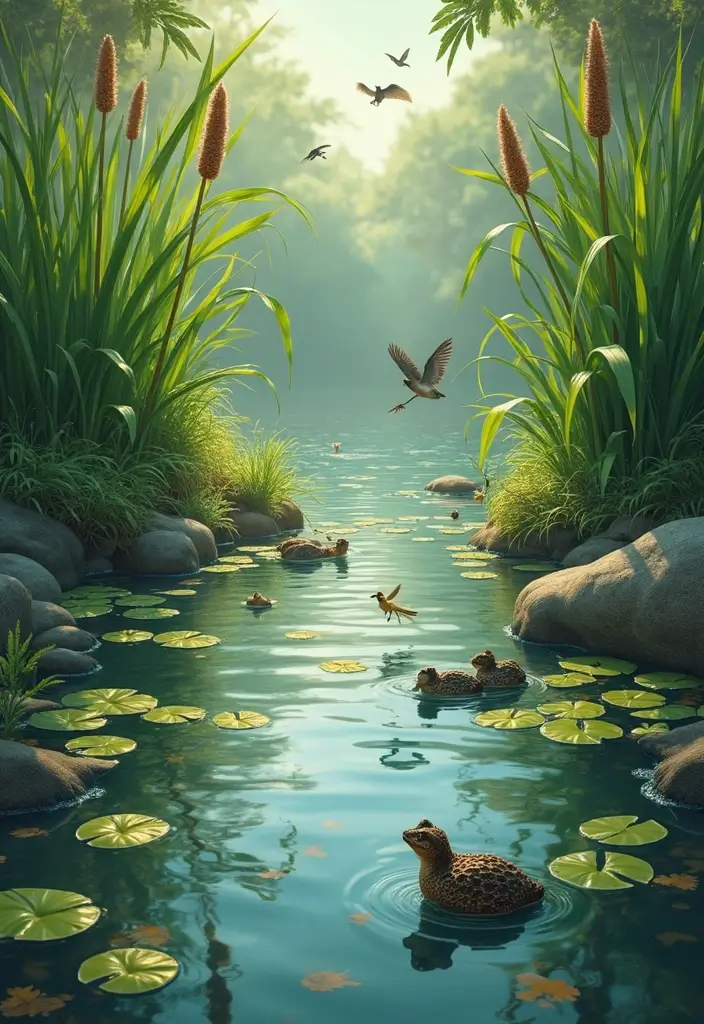
By introducing cat tails into your water garden, you also create a welcoming habitat for various wildlife. Birds, frogs, and beneficial insects thrive in areas with abundant cat tails, making your pond a vibrant ecosystem.
Their dense growth provides shelter and nesting sites for birds while the foliage helps maintain a stable environment for aquatic creatures. You can encourage wildlife by placing feeders or nesting boxes nearby, attracting even more species to your garden.
In addition to their aesthetic benefits, cat tails serve as a food source for many animals, including ducks and beavers. Observing these creatures in your garden can be a delightful experience, enhancing your connection with nature.
– Create small islands of cat tails for nesting birds.
– Avoid using chemicals near the pond to protect wildlife.
– Observe and document the diversity of species that visit your garden.
6. Add Texture and Movement
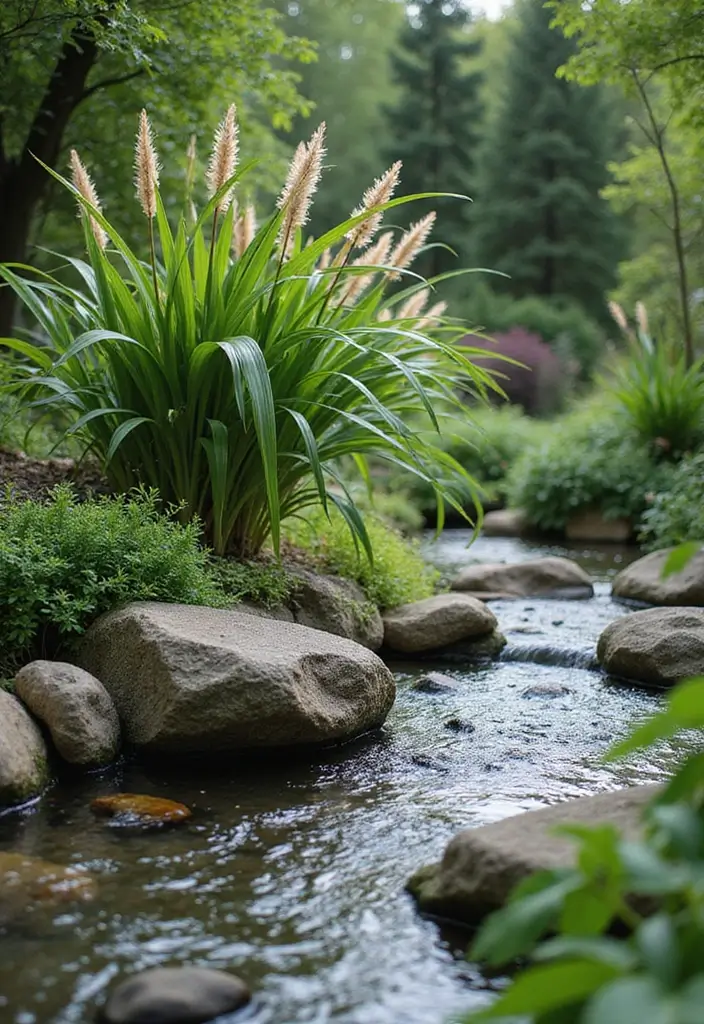
Cat tails bring an inspiring texture and movement to your water garden. Their tall, slender stems sway gently in the breeze, creating a captivating display of motion that adds life to your pond.
To enhance this visual effect, consider planting in layers with shorter plants around the base of the cat tails. This approach not only adds dimension but also highlights the cat tails’ flowing movement against the stillness of the water. Pair them with bold foliage plants for a striking contrast that draws the eye.
You can also use decorative stones or driftwood to create a naturalistic setting that complements the movement of the cat tails, further enhancing your pond’s aesthetic. This dynamic combination fosters a lively atmosphere that’s tranquil yet visually engaging.
– Use varying heights of plants for layered texture.
– Incorporate natural elements like rocks for a cohesive look.
– Regularly prune cat tails to maintain their height and movement.
7. Create a Themed Water Garden
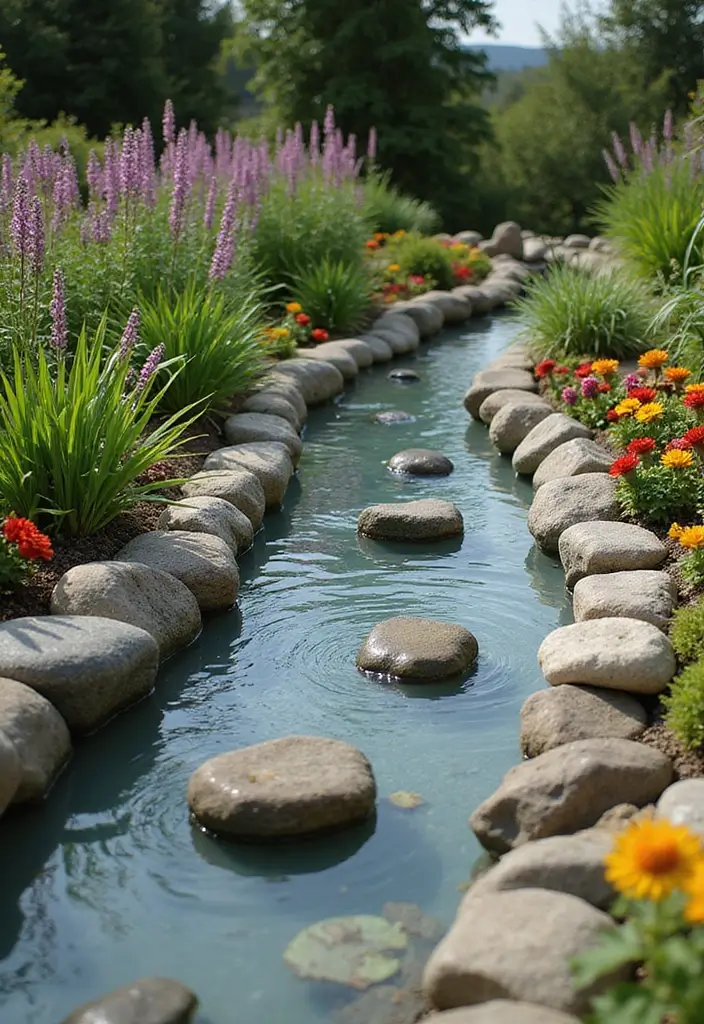
Designing a themed water garden allows you to explore your creativity while incorporating cat tails for a unique effect. Consider a tranquil Zen garden or a vibrant wildlife refuge. Cat tails can seamlessly fit into various themes while bringing their benefits to the table.
In a Zen-inspired garden, plant cat tails alongside smooth stones and raked gravel, emphasizing simplicity and tranquility. For a wildlife haven, pair them with colorful flowers and dense foliage to attract diverse species. This approach creates a multi-sensory experience that captivates visitors.
Ensure your plant choices align with the theme you’re aiming for. Mixing textures, colors, and heights in different zones can enhance the overall aesthetic while keeping the natural feel. Themed gardens invite exploration and provide a perfect backdrop for relaxation or gathering.
– Think about your desired atmosphere when selecting plants.
– Mix traditional and native plants for a cohesive look.
– Regularly update your design to keep it fresh and engaging.
8. Highlight with Garden Lighting
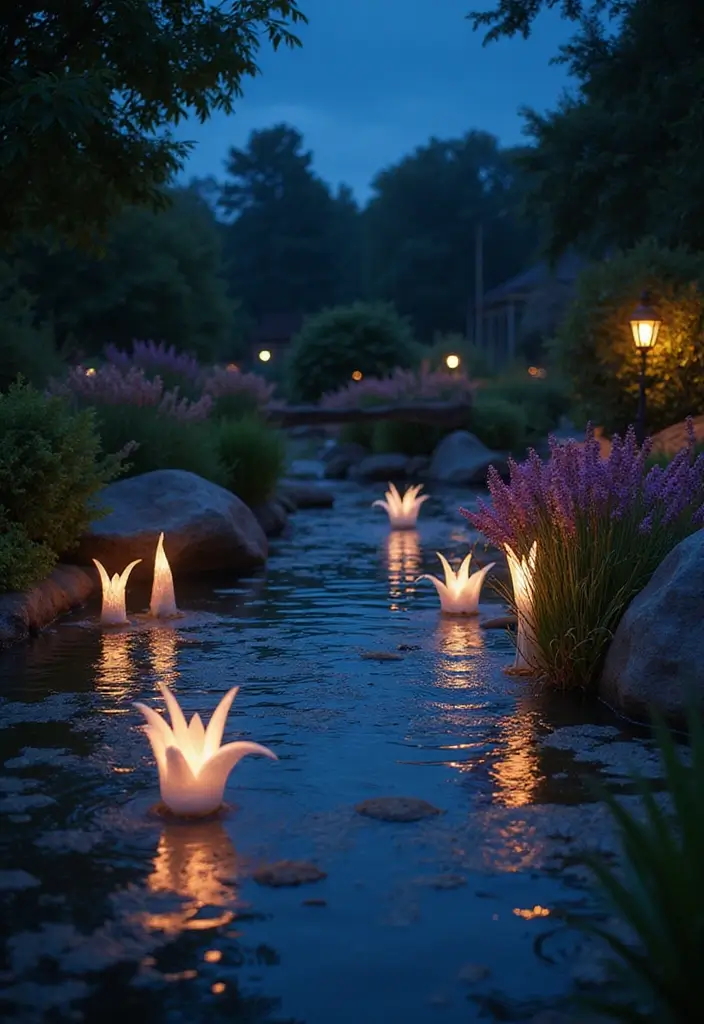
If you want to extend the beauty of your water garden into the evening, consider using garden lighting to highlight your cat tails. Strategically placed lights can showcase their graceful outlines, creating a magical atmosphere at night.
Incorporate solar-powered lights along the pond’s edge or place lanterns among the cat tails for a soft glow that enhances the visual appeal. This creates a stunning nighttime oasis where shadows dance with the water’s surface, drawing people into your beautifully lit space.
Be creative with your lighting design. Use uplighting to accentuate the height of the cat tails, or ambient lighting to create a soft, twilight effect that makes your water garden enchanting. This thoughtful approach to lighting can enhance your overall garden experience, making it perfect for gatherings or serene evenings alone.
– Choose warm, soft lights for a cozy atmosphere.
– Experiment with different light placements to find what works best.
– Include battery-operated lanterns for added elegance.
9. Incorporate Cat Tails into Container Gardens
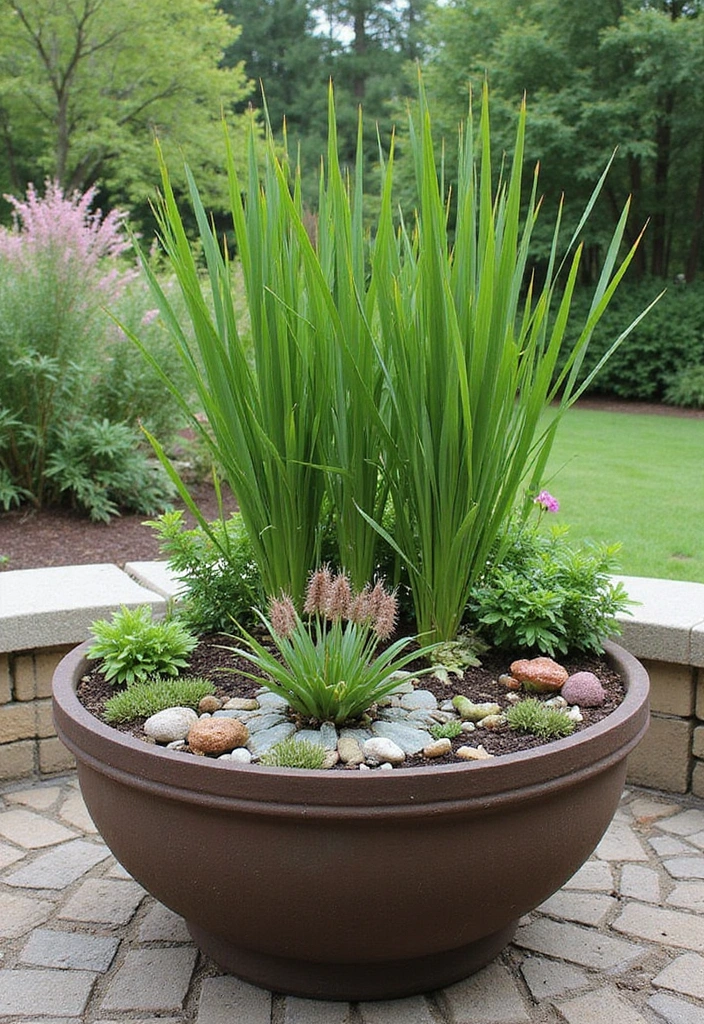
If you’re limited on space, don’t worry! You can still enjoy the beauty of cat tails by incorporating them into container gardens. This allows you to create a mini water feature on your patio or balcony, bringing the charm of a water garden into smaller spaces.
Choose a large, durable container that can hold water, ensuring proper drainage for the plants inside. Place cat tails alongside other smaller aquatic plants to create a balanced and visually appealing arrangement. This setup can be a stunning focal point for any outdoor area.
Container gardens are also easier to manage when it comes to maintenance and can be moved to different locations as needed. Be mindful of the growing conditions in your container, ensuring adequate sunlight and water quality for your cat tails to thrive.
– Opt for large containers with proper drainage.
– Combine with smaller aquatic plants for a balanced look.
– Move containers to optimize sunlight exposure.
10. Introduce a Waterfall Feature
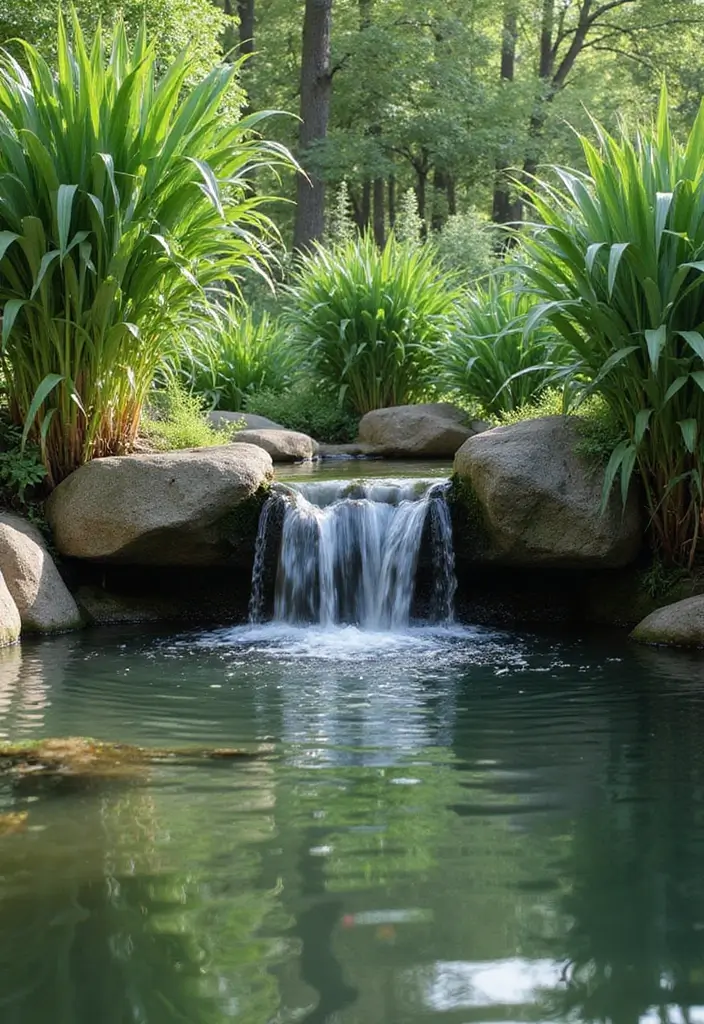
Enhancing your pond with a waterfall not only adds a stunning visual but also increases aeration and circulation, benefiting both your cat tails and other aquatic plants. The sound of cascading water creates a tranquil ambiance that adds to the overall serenity of your water garden.
Positioning cat tails near the waterfall can create a beautiful contrast of movement and stillness. Their tall, striking forms can frame the waterfall, drawing attention to the feature while providing a natural look. This setup also encourages wildlife to visit, enhancing your pond’s ecosystem.
Ensure that the waterfall’s flow is gentle enough to avoid disturbing the plant life, especially the cat tails, which thrive in calmer waters. Regular maintenance will be essential to keep both the waterfall and plants healthy and thriving.
– Install a gentle waterfall for optimal plant health.
– Use cat tails to frame the waterfall for added drama.
– Regularly clean the waterfall to prevent buildup.
11. Explore Mix and Match Plantings
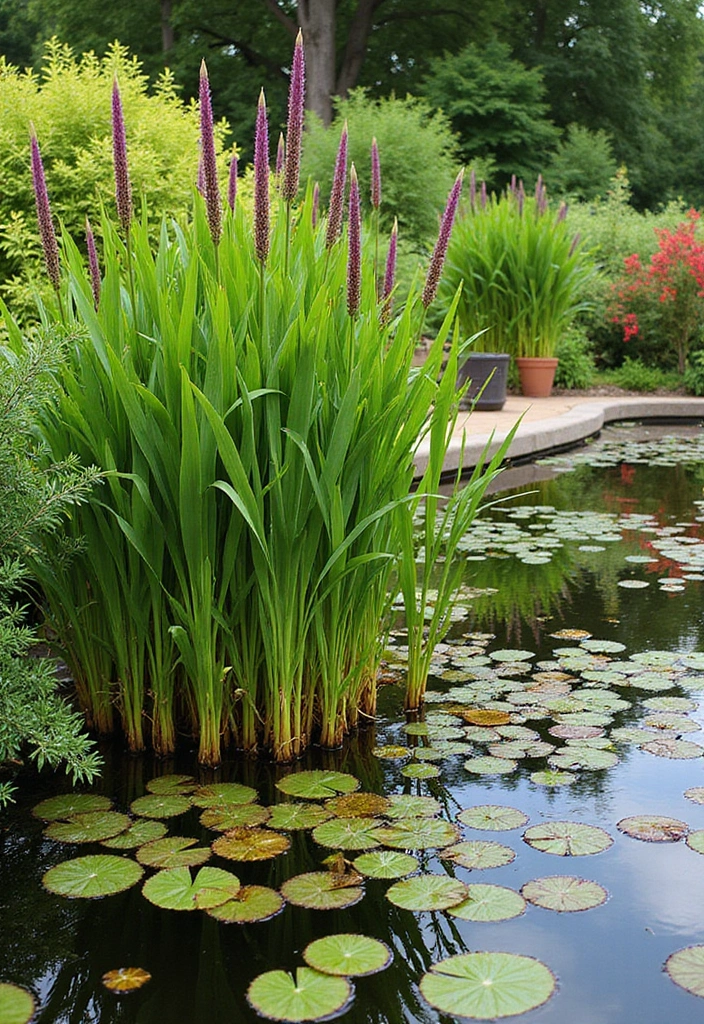
Cat tails can be effectively combined with a variety of other water garden plants, creating an engaging tapestry of colors and textures. Experimenting with different combinations can lead to a unique and personalized aquatic landscape.
Consider pairing cat tails with aquatic ferns, rushes, or even flowering plants like marsh marigold. This not only enhances the aesthetic but also contributes to a diverse ecosystem, promoting biodiversity in your pond. Each plant plays a role, whether it’s filtering water, sheltering wildlife, or adding visual interest.
As you mix and match, pay attention to the needs of each plant—sunlight, water depth, and soil type are crucial for their success. Observing how these plants interact can also lead to delightful surprises as they bloom and grow together over time.
– Choose plants with similar sunlight and water needs.
– Regularly reassess plant health and layout.
– Enjoy experimenting with different combinations!
12. Create Floating Islands
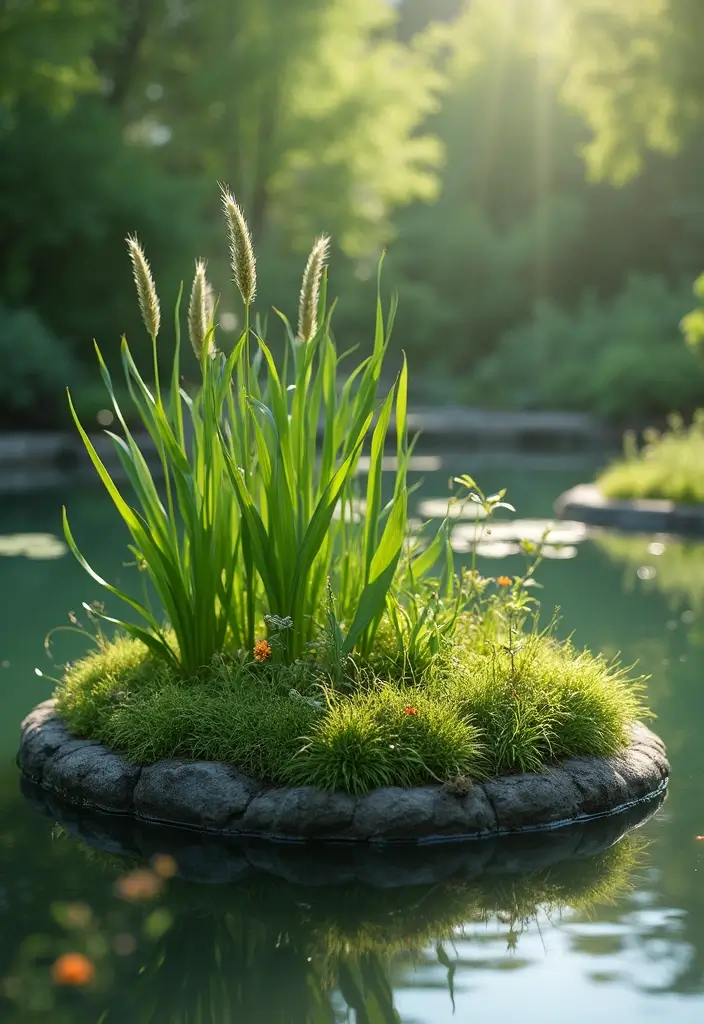
A creative and ecological approach to incorporating cat tails is to create floating islands in your pond. These islands can support various plants, including cat tails, and provide additional habitats for wildlife.
To create a floating island, use a sturdy base made of pond liner, buoyant materials, or even repurposed plastic containers. Secure cat tails and other aquatic plants in soil pockets within the island. As the island floats, the cat tails will thrive, while the island itself adds an interesting visual element to your pond.
This technique not only adds beauty but also enhances the pond’s biodiversity. Floating islands can help filter pollutants and provide shelter for small fish and aquatic insects. Be sure to anchor them properly to prevent them from drifting away during storms or heavy winds.
– Use buoyant materials for a stable base.
– Plant a variety of plants for a full look.
– Regularly check the stability and health of the floating island.
Create floating islands with cat tails in your pond! Not only do they look stunning, but they also boost wildlife habitats. Dive into creativity and watch nature thrive!
13. Craft a Natural Border
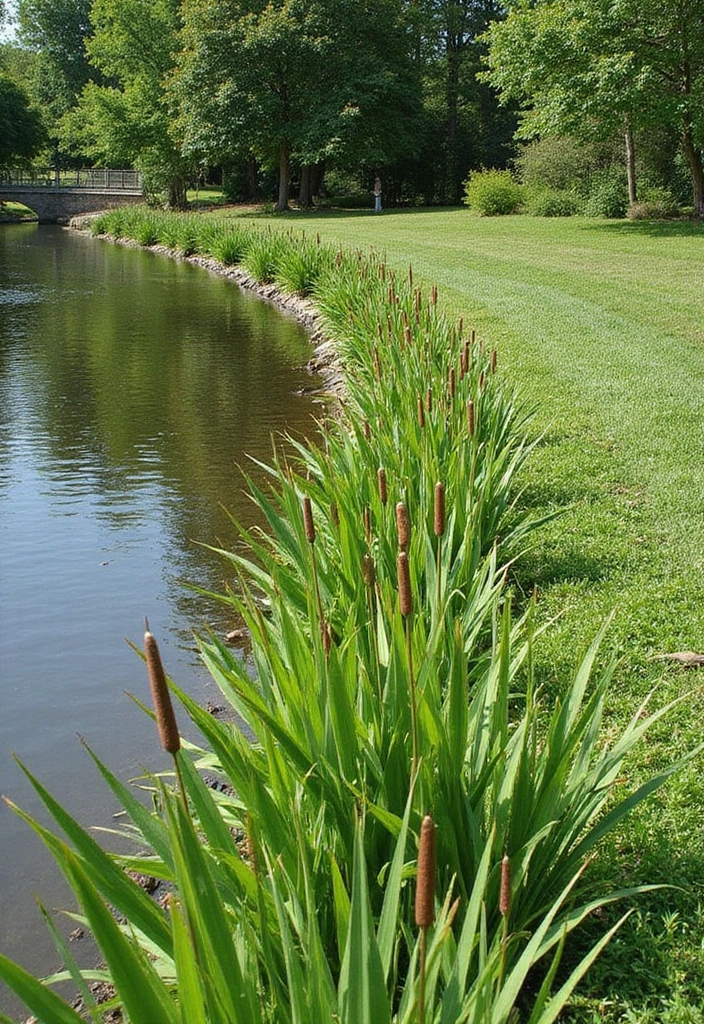
Transforming the edges of your pond with cat tails can create a beautiful natural border. By defining your pond’s perimeter with these sturdy plants, you enhance the visual appeal while contributing to the stability of the shoreline.
Consider planting cat tails in staggered rows, which not only provides a lush look but also helps manage erosion. Their roots bind the soil together, reducing the likelihood of soil runoff, especially during heavy rains. This natural border can also serve as a transition from land to water, making the edges of your pond more inviting.
For added interest, mix in other border plants that complement cat tails, such as water mint or golden club, which can enhance the overall effect without overshadowing the cat tails. Maintenance is key—regular trimming and thinning can keep your natural border looking pristine.
– Stagger plants for a full and lush appearance.
– Combine with other shoreline plants for texture.
– Regular maintenance ensures a neat look.
14. Implement Companion Planting
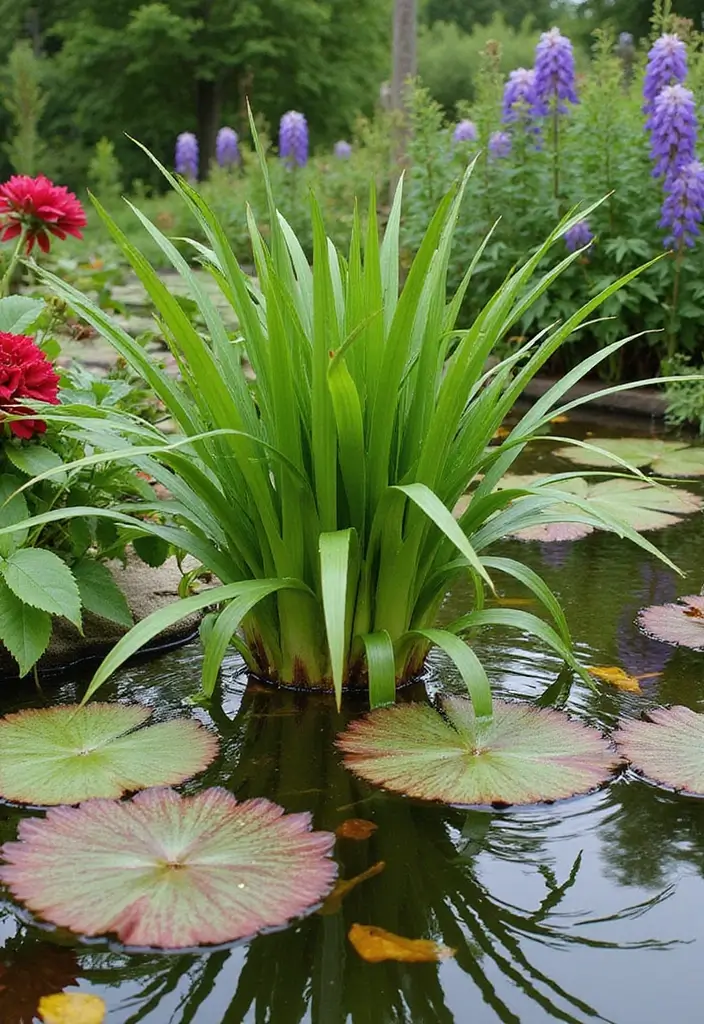
Companion planting involves pairing cat tails with specific plants that enhance each other’s growth and health. This method can lead to a more vibrant and balanced water garden.
For example, combining cat tails with plants like pickerel rush can benefit both, as they often share similar growth conditions. The foliage of pickerel rush can provide some shade for cat tails, which helps prevent overheating in hot weather.
Additionally, companion plants can attract beneficial insects that can help control pest populations. Regular observation of plant interactions can provide valuable insights into your garden’s dynamics, allowing you to optimize your design further.
– Research plant compatibility for optimal growth.
– Observe interactions for beneficial or adverse effects.
– Experiment with different combinations over time.
15. Add a Splash of Color with Flowers
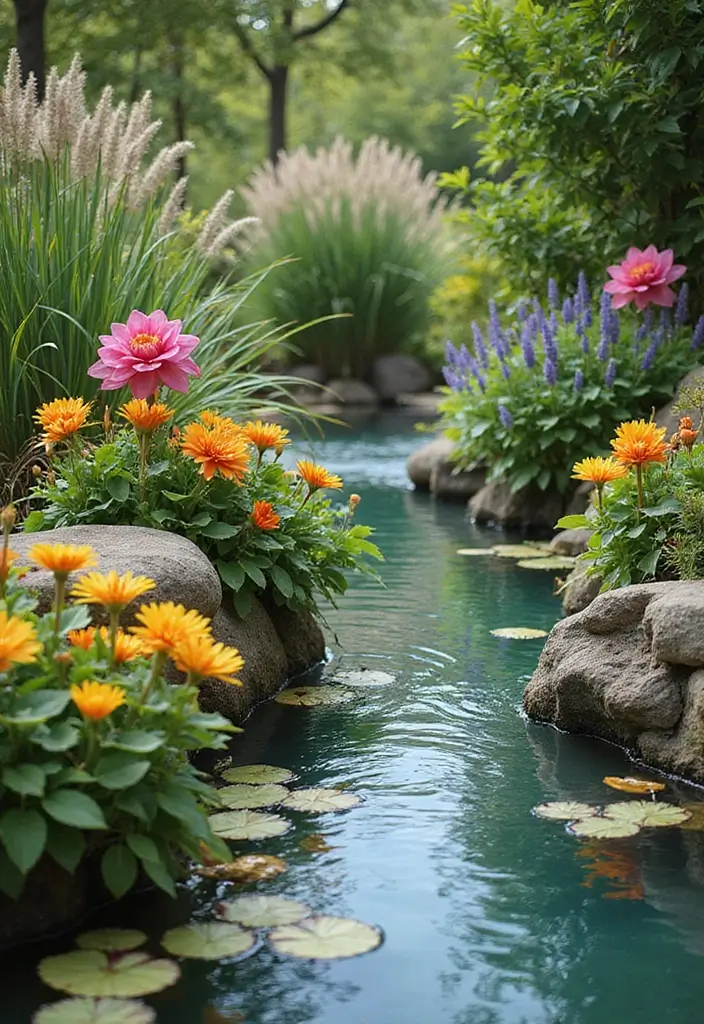
Incorporating flowering plants alongside cat tails can add a vibrant color palette to your water garden. Species like water poppy, marsh marigold, or blooming rushes create a stunning contrast with the green foliage of cat tails.
Plant these flowering varieties among the cat tails to create a visually dynamic environment that draws the eye. Consider the bloom times of each plant to ensure continuous color throughout the seasons. This approach not only enlivens your space but also attracts pollinators like bees and butterflies, enhancing the ecosystem.
When designing your flower arrangements, think about the height and spread of each plant to ensure they complement rather than overshadow each other. Regular maintenance, like deadheading flowers and managing growth, helps keep your garden looking its best.
– Choose flowers that bloom at different times for continual color.
– Mix short and tall plants for visual interest.
– Regular maintenance ensures flowers and cat tails coexist harmoniously.
16. Design a Rain Garden
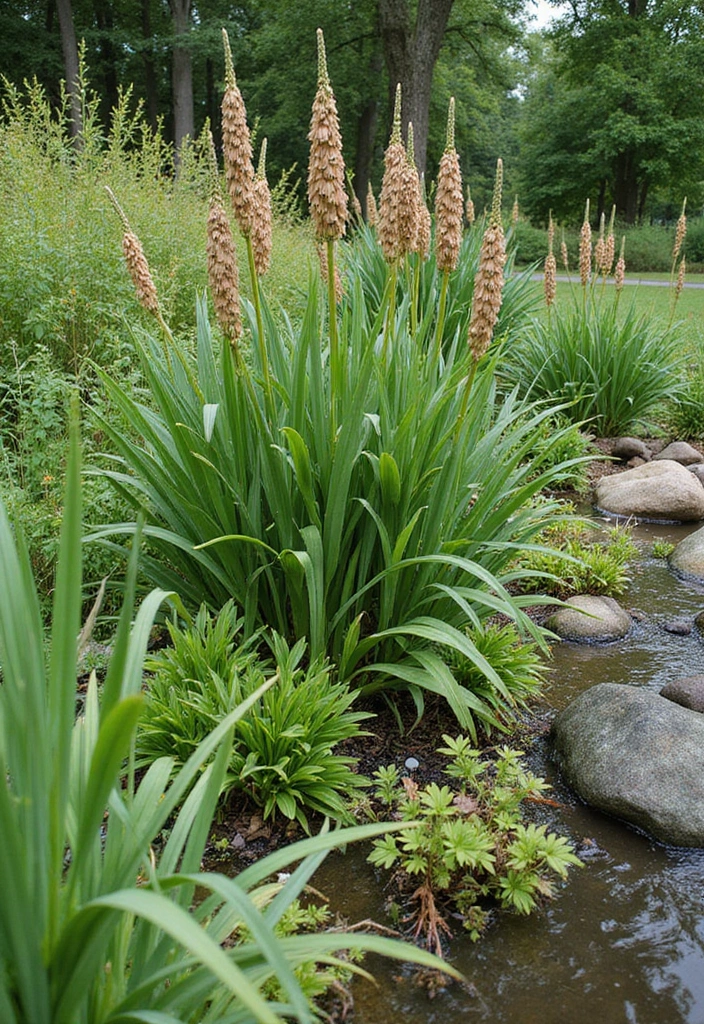
Rain gardens can greatly benefit from the presence of cat tails. These gardens are designed to absorb rainwater runoff, and the cat tails’ ability to thrive in wet conditions makes them a natural fit.
When establishing a rain garden, plant cat tails in the lowest areas to allow them to soak up excess water. They will not only thrive but also improve water quality by filtering pollutants. This method creates a sustainable landscape while using native plants to support local wildlife.
As you design, incorporate other wetland plants to enhance the aesthetic and functionality of the rain garden. This approach leads to a beautiful garden that serves a practical purpose while nurturing biodiversity.
– Identify areas prone to water accumulation for optimal placement.
– Mix in other native wetland species for a diverse garden.
– Regularly check for invasive plants to maintain the health of your rain garden.
17. Explore Variegated Cat Tail Varieties
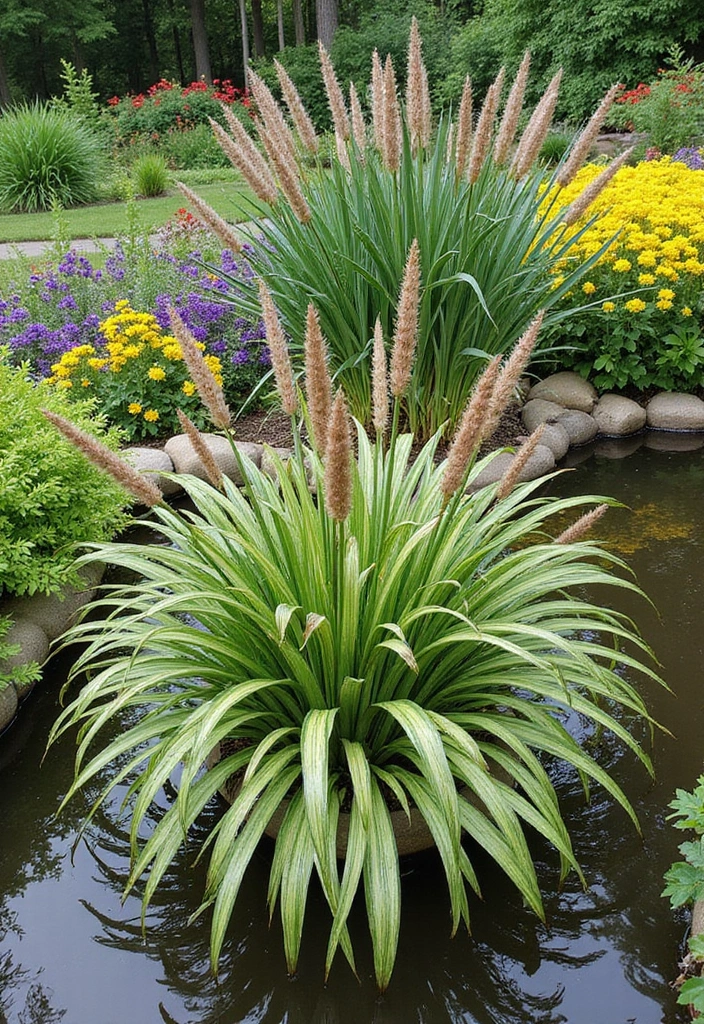
Variegated cat tails offer a unique twist on the traditional green variety, featuring striking patterns and colors that can elevate your water garden’s design. These plants typically display creamy white or yellow stripes against green leaves, providing visual interest throughout the growing season.
Incorporating variegated varieties adds depth to your garden while maintaining the eco-friendly benefits of standard cat tails. They pair beautifully with other colorful aquatic plants, allowing you to experiment with contrasts in texture and color.
When planting, ensure they receive adequate sunlight and maintain healthy soil conditions. Observing how they interact with other plants can lead to delightful surprises and a one-of-a-kind aquatic display.
– Choose variegated varieties that complement your existing plants.
– Pay attention to their growing conditions for optimal health.
– Regularly check for pests that could affect their unique patterns.
18. Introduce Cat Tails for Seasonal Interest
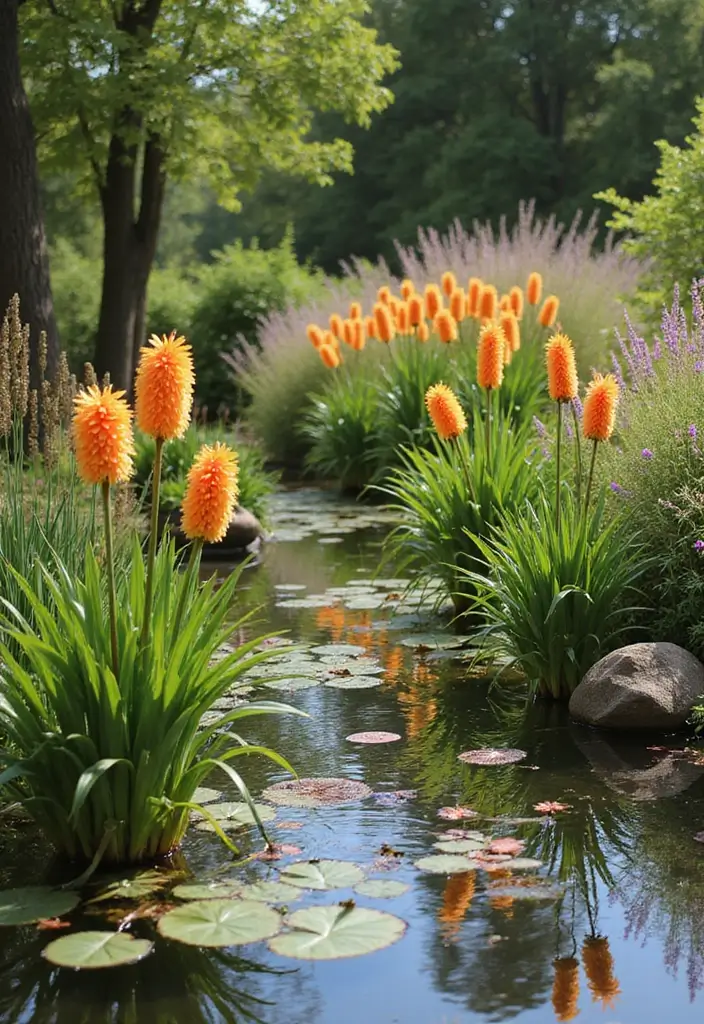
Cat tails provide visual interest throughout the seasons, contributing dynamic beauty to your water garden. In spring, their vibrant green shoots emerge, signaling new growth and life. By summer, they reach their full height, showcasing their iconic fluffy flower spikes.
As autumn approaches, the foliage can turn golden, adding warmth to your landscape. When winter arrives, the dried flower spikes create a whimsical, frosty silhouette against the snow, adding serene beauty to your garden.
By carefully planning your planting schedule, you can ensure that cat tails are complemented by other plants that bring seasonal color, creating a year-round visual feast. Regular maintenance will help preserve their strong structure and visual appeal throughout the changing seasons.
– Combine cat tails with other seasonal plants for continuous interest.
– Plan for seasonal color changes for a dynamic display.
– Regular maintenance ensures continued health and beauty.
19. Build a Miniature Water Garden
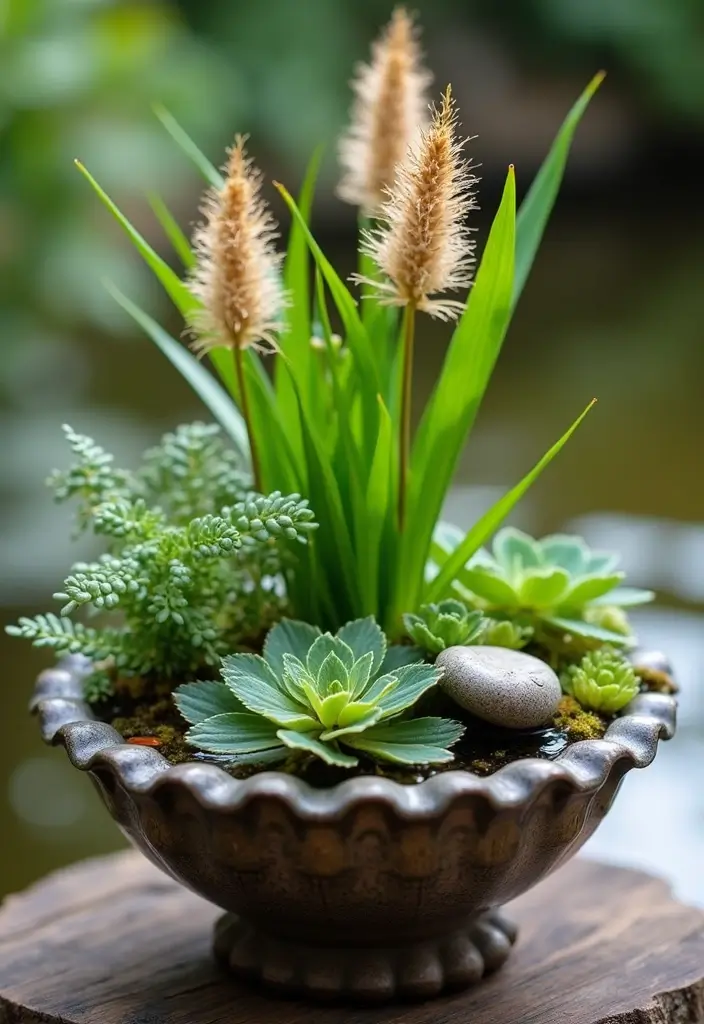
Creating a miniature water garden can be a fun project where cat tails play a pivotal role. These smaller designs can be placed in garden beds, patios, or balconies, allowing you to incorporate water-loving plants in limited spaces.
To start your miniature garden, choose a suitable container and fill it with water-loving plants, including cat tails, that thrive in smaller environments. This approach brings the tranquility of a larger water garden into a compact space, making it accessible to everyone.
Incorporate decorative elements like small stones, pebbles, or miniature fountains to enhance the aesthetic. Regular care is crucial for miniature gardens as plants in smaller containers can dry out more quickly. Monitor water levels and plant health to ensure a thriving mini oasis.
– Use containers with drainage and proper insulation.
– Include decorative elements for added charm.
– Regular monitoring and care are essential.
20. Utilize Cat Tails for Erosion Control
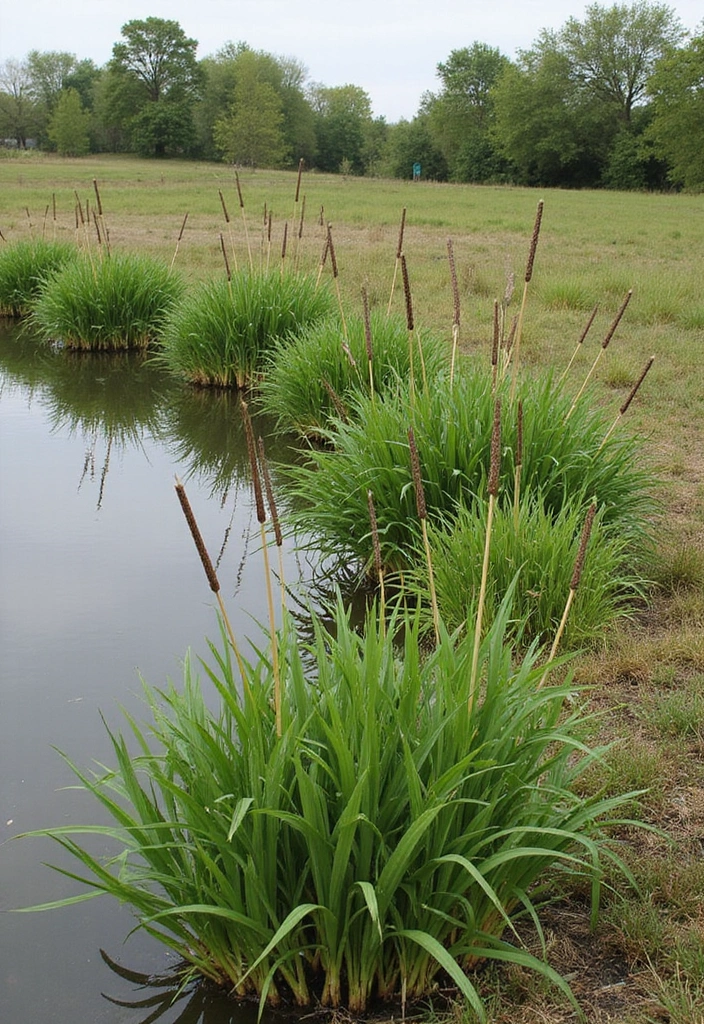
Cat tails are not just beautiful; they are also natural allies in preventing soil erosion around your water garden. Their robust root systems help to anchor soil in place, stabilizing the edges of your pond or stream.
When planting cat tails in areas prone to erosion, consider their positioning along the waterline. This will not only prevent soil runoff but also create a lush, green environment that enhances the natural beauty of your landscape. Additionally, they help filter water, improving quality and promoting a healthy ecosystem.
Regular maintenance is key to ensuring the health of your cat tails and the effectiveness of their erosion control properties. By managing their growth and promoting a balanced plant community, you can maintain the integrity of your water feature.
– Position near areas with high erosion risk.
– Monitor growth to prevent overcrowding.
– Regular planting assessments help maintain effectiveness.
21. Celebrate Cultural Traditions with Cat Tails
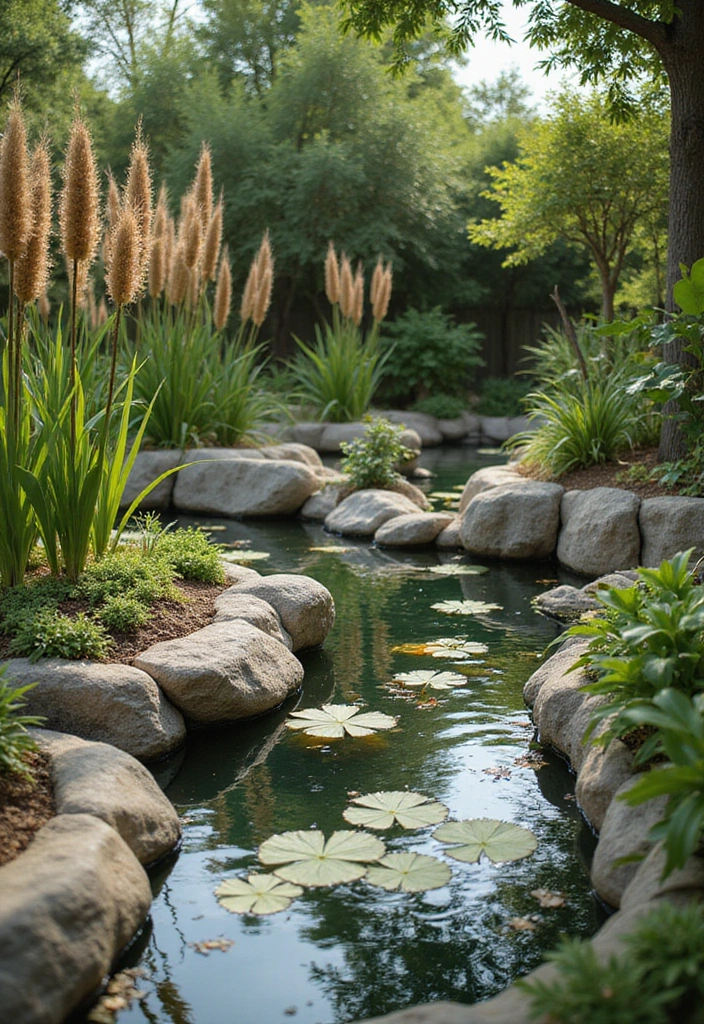
Cat tails have been celebrated in various cultures for their beauty and utility. Incorporating them into your water garden can add a cultural touch, reflecting respect for nature and local traditions.
In some cultures, cat tails are used in crafts, basketry, and traditional medicine, highlighting their versatility. You can create a themed garden that honors these practices by incorporating educational elements about the significance of cat tails in different cultures.
This approach not only beautifies your landscape but also invites guests to learn more about the natural world. It fosters appreciation for the cultural connections to plants and their roles in our lives.
– Research local cultural practices involving cat tails.
– Create educational signage to share information.
– Incorporate traditional elements into your garden design.
22. Embrace Minimalism with Cat Tails
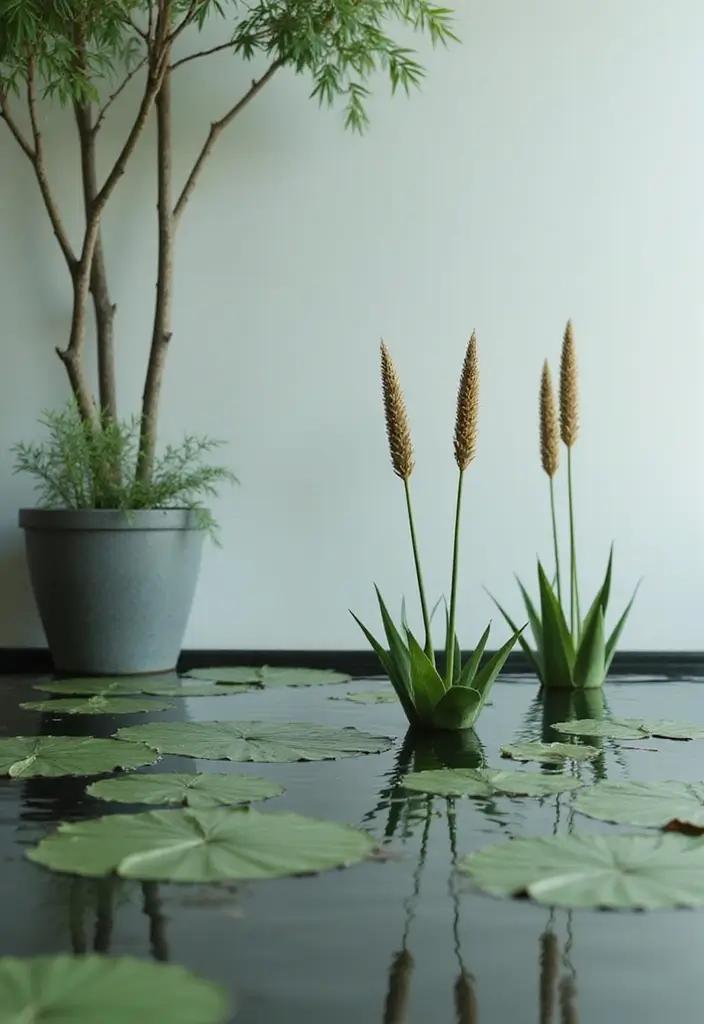
Embracing minimalism in your water garden design can lead to an elegant and serene atmosphere. Incorporating cat tails as key focal points aligns perfectly with this aesthetic, emphasizing simplicity and beauty in nature.
To create a minimalist design, focus on clean lines and a limited plant palette. Use cat tails in strategic placements to draw the eye without overwhelming the space. Their tall and slender form can create dramatic silhouettes that add to the peaceful ambiance.
Regular maintenance is essential to keep the minimalist garden looking fresh and tidy. Clean up any debris and manage plant growth to ensure the cat tails remain the highlights of your design.
– Limit the number of different plants for a clean look.
– Use cat tails as focal points in strategic locations.
– Regular maintenance keeps the design clean and appealing.
23. Explore Aquaponics with Cat Tails
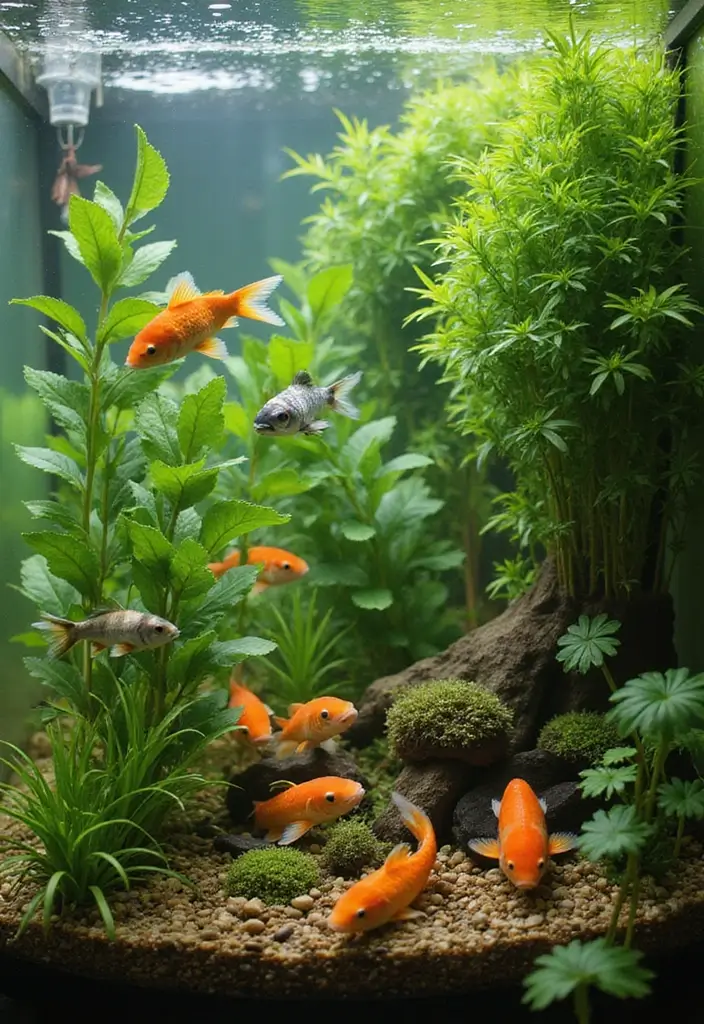
Aquaponics is a sustainable gardening method that combines aquaculture (raising fish) with hydroponics (growing plants in water). Incorporating cat tails into an aquaponics system can enhance both plant growth and fish health.
Cat tails can filter water and absorb excess nutrients, creating a healthier environment for fish while providing ideal growing conditions for various aquatic plants. This symbiotic relationship can lead to a flourishing ecosystem within your water garden.
Regular monitoring ensures the health of both fish and plants, allowing you to maintain the balance required for success in aquaponics. By emphasizing sustainability and education, you create a water garden that benefits both nature and the community.
– Research aquaponics systems for optimal success.
– Monitor water quality regularly for fish welfare.
– Consider integrating diverse plant species for increased resilience.
24. Document Your Garden Journey

As you incorporate cat tails into your water garden, consider documenting your journey to inspire others and track your progress. This practice not only celebrates your achievements but also can provide valuable insights for future gardening endeavors.
Take photos of different stages of growth, noting the changes in your garden throughout the seasons. Share your experiences on social media or gardening blogs to connect with fellow enthusiasts. This can foster a sense of community and shared knowledge, helping others in their gardening pursuits.
Moreover, keeping a journal can help you reflect on your successes and challenges, guiding your future gardening decisions. Celebrating your journey can enrich your connection to nature and inspire others to embrace gardening as a rewarding hobby.
– Regularly document plant growth and changes.
– Share your journey with the gardening community.
– Reflect on successes and challenges to improve future gardening.
25. Incorporate Sound for Tranquility
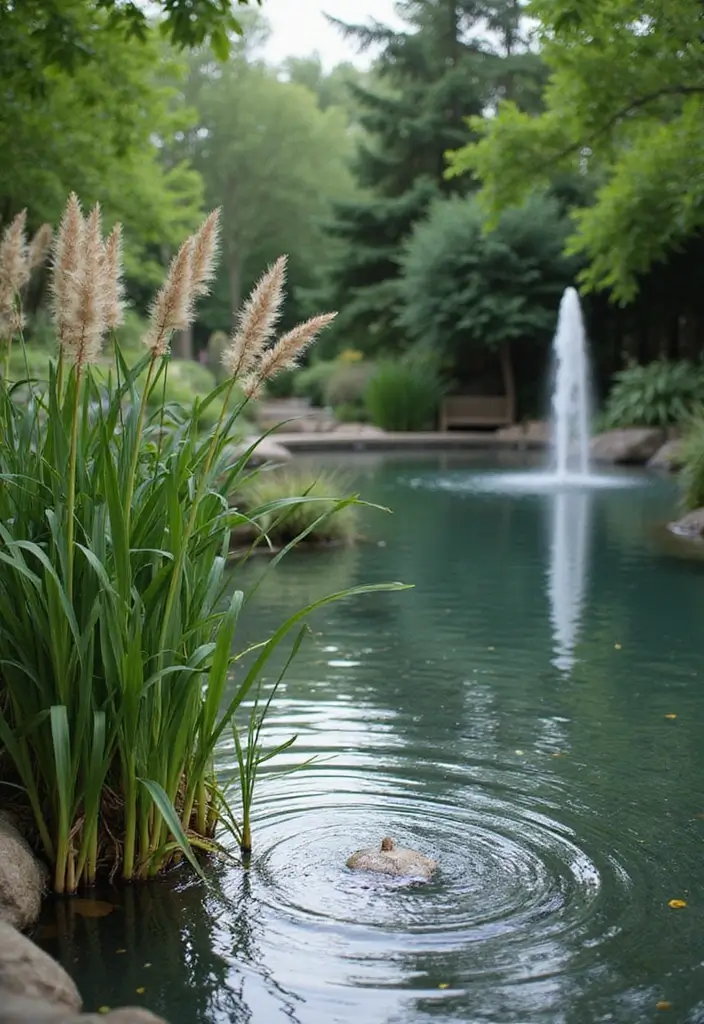
Adding elements that create sound in your water garden can enhance the calming atmosphere. While cat tails sway gently with the breeze, consider incorporating water features like fountains or gentle waterfalls to produce soothing sounds.
The sound of flowing water complements the visual serenity of cat tails, creating a peaceful retreat. These auditory elements can promote relaxation, making your garden an ideal spot for meditation or unwinding after a long day.
Experiment with different placements and types of water features to find what works best for your garden. Regular maintenance is key to ensuring that your sound elements remain functional and contribute to the tranquility of your space.
– Use gentle water sounds for a soothing effect.
– Experiment with different placements for optimal sound.
– Regularly maintain sound features for continued effectiveness.
Create your oasis: let the gentle sway of cat tails and the soothing sound of water transform your garden into a peaceful retreat for reflection and relaxation.
26. Explore Seasonal Planting Themes
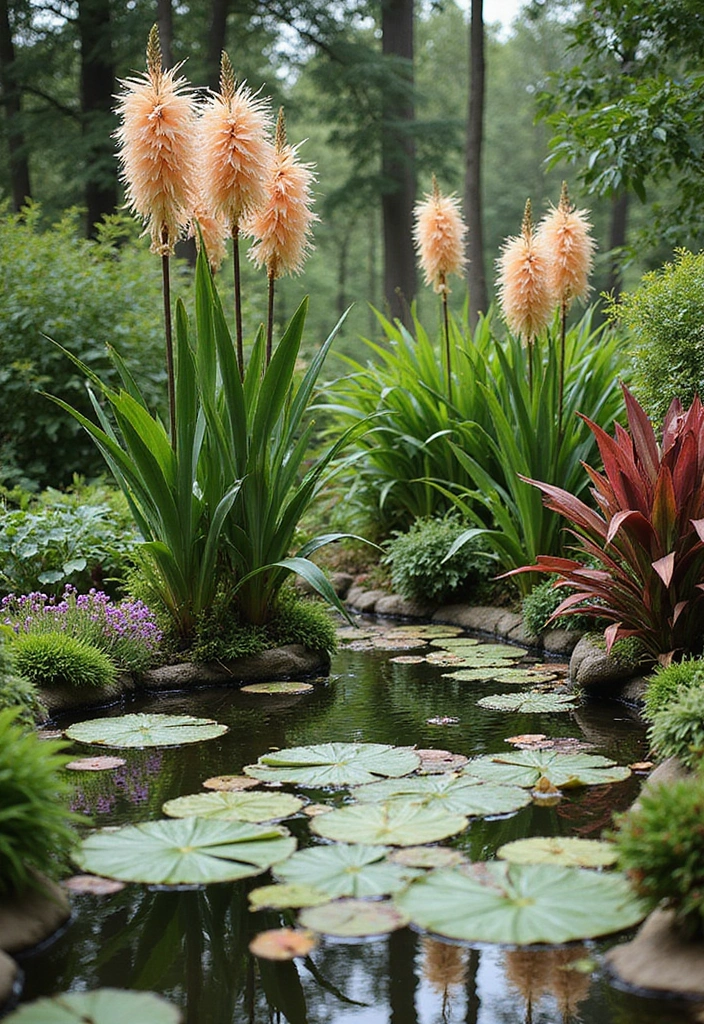
Incorporating cat tails into seasonal planting themes adds vibrancy and interest to your water garden. Consider having different focal plants for each season, using cat tails as a consistent backdrop that showcases seasonal colors.
During spring, highlight cat tails with blooming aquatic flowers like water lilies or iris, while in summer, pair them with lush greens and brightly colored blooms. In autumn, showcase warm tones around the cat tails, contrasting beautifully with their tall, graceful spikes.
This seasonal adaptability keeps your garden fresh and engaging throughout the year. Regularly reassess plant health and layout to ensure each theme shines through optimally.
– Plan plant groupings tailored to seasonal color schemes.
– Regularly refresh the annual plantings to maintain interest.
– Monitor connections between seasonal plants for optimal growth.
Embrace the seasons! Let cat tails plants be your water garden’s canvas, transforming each season into a vibrant masterpiece of color and texture.
27. Designate a Relaxation Zone
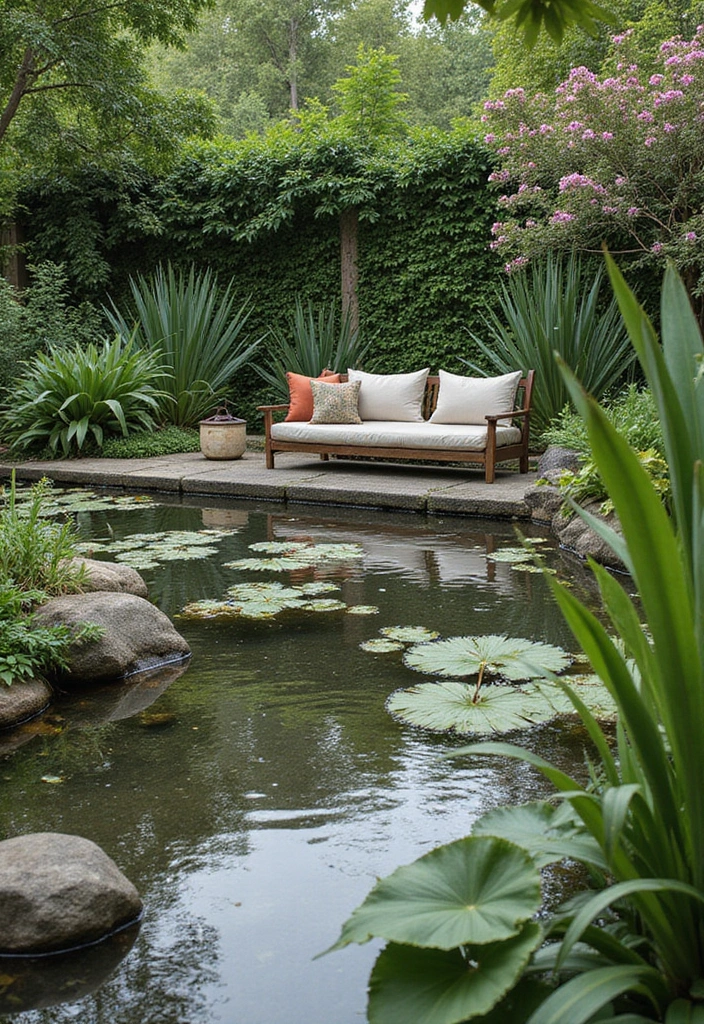
Creating a relaxation zone in your water garden can enhance your outdoor experience, with cat tails playing a central role in the design. By positioning seating near clusters of cat tails, you can enjoy the calming effect they have on the ambiance.
Consider using natural materials like wooden benches or stone seating to blend seamlessly with the environment. This approach encourages mindfulness and appreciation of nature, allowing you to unwind in your peaceful space. You can also add soft cushions or blankets for added comfort.
As you design your relaxation zone, ensure the seating is positioned to allow for optimal viewing of all your garden elements, including water features and flora. Regular maintenance of the area will keep it inviting and enjoyable for all who visit.
– Use natural materials to enhance the organic feel.
– Position seating for the best views of the garden.
– Regularly tidy the area for a welcoming atmosphere.
28. Create Educational Garden Spaces
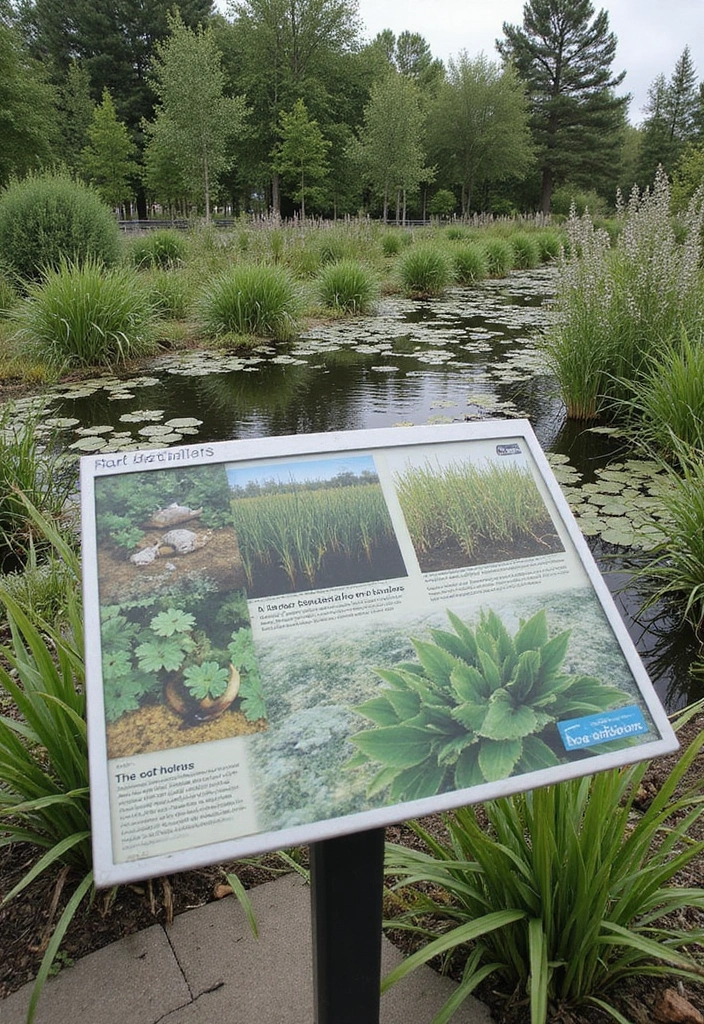
Incorporating educational elements into your water garden can enhance understanding of ecology and plant life, with cat tails serving as a focal point. Create informative signage or interactive displays that teach visitors about the benefits of cat tails and their role in the ecosystem.
By engaging with the community, you can foster a greater appreciation for nature and gardening. Consider hosting workshops or guided tours to share your passion and knowledge with others.
This approach invites curiosity and inspires future generations to connect with and protect natural resources. Regular updates to your educational elements can keep your garden relevant and fresh.
– Use clear and engaging signage for educational purposes.
– Host events to share knowledge and promote community engagement.
– Regularly update displays to reflect changes in your garden.
29. Celebrate Your Love for Gardening
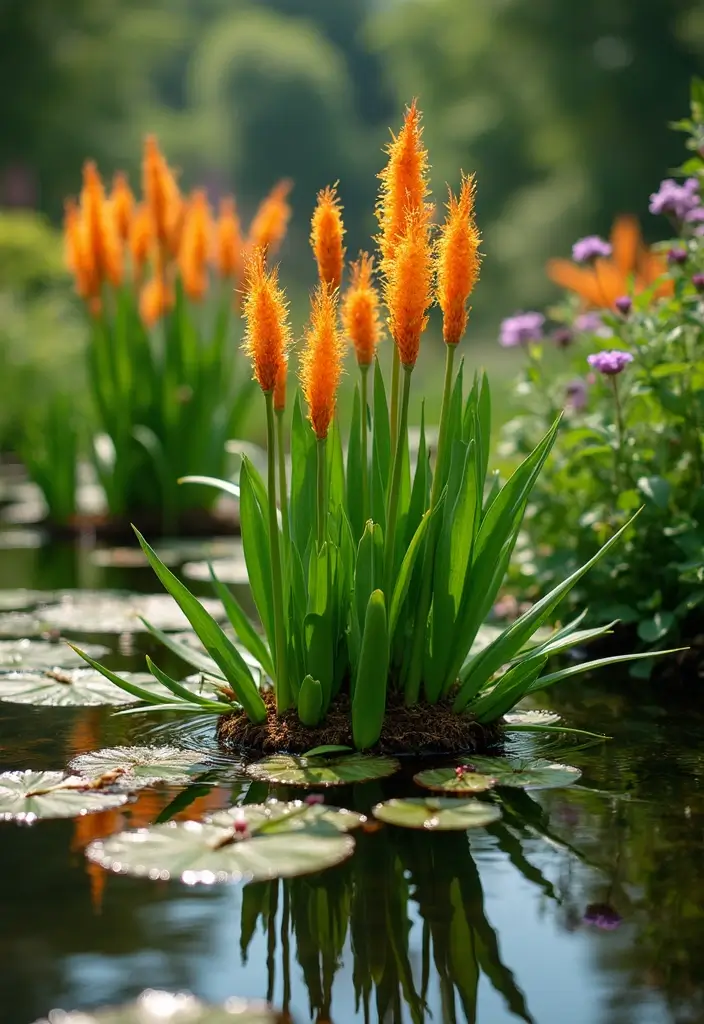
Your water garden is a reflection of your passion for gardening. Incorporating cat tails not only beautifies your space but celebrates your dedication to cultivating a unique outdoor experience. Share your gardening journey with friends, family, and fellow enthusiasts to spread joy and inspire others.
Consider organizing garden tours, participating in community events, or joining gardening clubs to connect with others who share your interests. This engagement helps build a supportive community that celebrates the joys of gardening.
Your love for gardening allows you to create a personal haven that encourages exploration and appreciation of nature’s beauty. Regularly sharing your progress can also motivate and inspire others to get involved in gardening.
– Engage with local gardening communities to build connections.
– Share your journey through social media or blogs.
– Inspire and motivate others through your gardening passion.
30. Reflect on Your Gardening Journey

As you cultivate your water garden and incorporate cat tails, take moments to reflect on your gardening journey. This practice encourages mindfulness and appreciation for the beauty and challenges of gardening.
Consider keeping a gardening journal documenting your progress, sharing successes, and acknowledging areas for improvement. This reflection can provide valuable insights, helping you grow not just as a gardener but as a steward of nature.
Embrace the lessons learned along the way and celebrate the changes in your garden throughout the seasons. Regularly revisiting your journey allows you to recognize growth and fosters a deeper connection to your outdoor space.
– Keep a journal to document your gardening experiences.
– Reflect on both successes and challenges for future growth.
– Celebrate seasonal changes to appreciate your hard work.
Reflect on your gardening journey: every cat tail planted tells a story. Embrace each lesson, celebrate your growth, and let your water garden flourish as a testament to your dedication and love for nature.
Conclusion
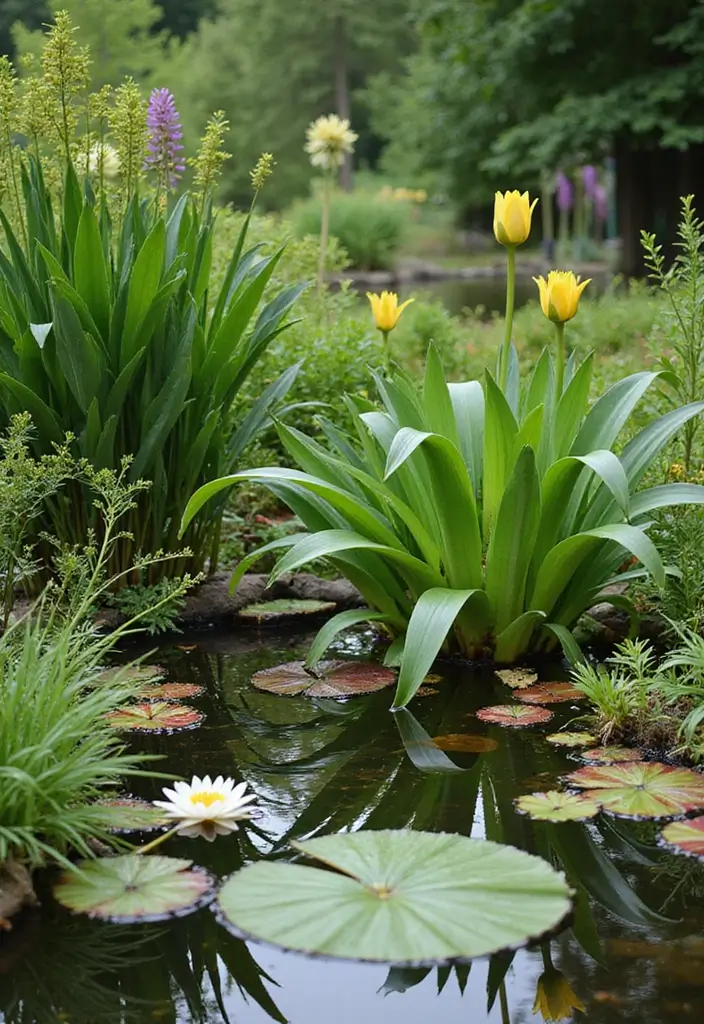
Cat tails are a fantastic addition to any water garden, offering not just visual beauty but also ecological benefits. Whether used in traditional settings or creative designs, they can enhance the overall aesthetic and functionality of your garden space. Embrace these 30 ideas and let your creativity flow as you integrate these magnificent plants into your water features or ponds.
Every garden tells a story, and with cat tails, your water garden will flourish with life and beauty. Share your experiences with fellow gardeners, and together, let’s celebrate the wonders of nature through our love for gardening.
Frequently Asked Questions
What Are Cat Tails Plants and Why Are They Ideal for Water Gardens?
Cat tails, known for their tall and graceful appearance, are aquatic plants that thrive in wet conditions, making them perfect for water gardens. Their robust root systems not only stabilize the pond edges but also provide natural filtration by absorbing excess nutrients and pollutants, contributing to a healthier aquatic environment.
Incorporating cat tails into your garden enhances its aesthetic appeal while fostering biodiversity, as they provide habitats for various wildlife.
How Should I Care for Cat Tails in My Water Garden?
Caring for cat tails is relatively easy! They prefer full sun and can tolerate a range of water depths, making them versatile for different pond designs. Regularly check for any dead foliage and remove it to encourage healthy growth. Additionally, ensure they have enough room to spread, as they can grow quite tall and wide. Remember to monitor water quality and nutrient levels, as healthy water contributes to their vibrant growth.
With these simple care tips, your cat tails will flourish beautifully in your water garden!
Can Cat Tails Help Improve Water Quality in My Pond?
Absolutely! One of the standout benefits of cat tails is their natural ability to filter water. Their roots absorb excess nutrients and pollutants, significantly improving overall water quality. By incorporating cat tails into your pond, you’re not just adding beauty; you’re also enhancing the ecosystem. This natural filtration helps prevent algae blooms and keeps the water clear, creating a healthier environment for fish and other aquatic life.
So, adding cat tails is a win-win for both aesthetics and pond health!
What Are Some Creative Ways to Incorporate Cat Tails into My Pond Landscaping?
There are numerous ways to creatively incorporate cat tails into your pond landscaping! You can plant them along the edges to create a stunning vertical element, or use them as a natural privacy screen to enhance your outdoor oasis. Consider pairing them with colorful water lilies for a delightful contrast or even creating floating islands with cat tails and other aquatic plants.
Experiment with different placements and combinations to craft a unique and vibrant water garden that reflects your personal style!
Are Cat Tails Invasive, and How Can I Manage Their Growth?
While cat tails are wonderful additions to water gardens, they can become invasive if not managed properly. To prevent overgrowth, consider planting them in contained areas or using barriers to restrict their spread. Regular maintenance, such as trimming and dividing plants periodically, helps keep their growth in check. By monitoring their expansion and taking proactive measures, you can enjoy the beauty of cat tails without letting them take over your pond.
Stay vigilant, and you’ll maintain a balanced and beautiful aquatic environment!

